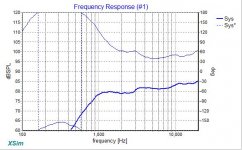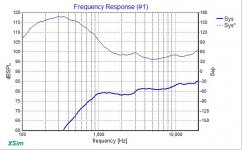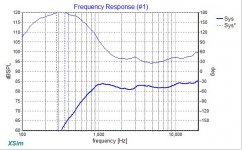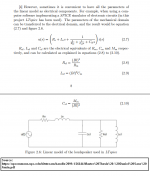Here SoundStage! Hi-Fi | SoundStageHiFi.com - Sonus Faber Olympica III Loudspeakers there is an explanation of what at SF they intend for paracross topology.
So shunt components are irrelevant? This is how many DIYers used to talk, but a 'professional' appealing to a misconception, I'm not as sure.
Yes. This case under question can be tested with a simulator.
George
The RL high pass filter is one of the two oldest forms of high pass network, dating back to the 1890s. I've used it myself on several designs, as it's interesting and can have some useful properties, if you can cope with the compromises involved. Amazing they managed to patent it after a century of widespread use.
Last edited:
Here SoundStage! Hi-Fi | SoundStageHiFi.com - Sonus Faber Olympica III Loudspeakers there is an explanation of what at SF they intend for paracross topology.
So a variable slope design, most easily implemented as a notched 1st order. Not exactly what could be called a novel concept, given that it's widely used in many designs.
Yes. This case under question can be tested with a simulator.
Any LT spice model of a tweeter?
George
Here SoundStage! Hi-Fi | SoundStageHiFi.com - Sonus Faber Olympica III Loudspeakers there is an explanation of what at SF they intend for paracross topology.
Thanks for the article ... something I can't read at work.
Given my previous experience of Sonus Faber loudspeakers, it was intriguing to review the Olympica III. The earmarks of Sonus Faber speakers past are obvious: lavish woodwork, leather accents, string grilles, etc. But I could also see improvements in styling, and commensurate improvements in sound. That sound is still very distinctive -- there’s a sonic signature there, but one that’s far more natural and uncolored than the Sonus Fabers of yesteryear. Although my tastes lean toward strict neutrality, I not only greatly enjoyed how the Olympica III has been voiced, I loved the way it sounded overall. In my book, Sonus Faber is doing something very right.
It told me what I has suspected for a long time. Sonus Faber sold all there speakers previously based on beauty which is perfectly fine with me. I would gladly purchase a pair (if I had the money of course) and listen intensely with my eyes.
Hang about -are people seriously claiming that the shunt element of an RL high pass network is irrelevant? What drivel is this? To claim this is to say that the value of the shunt inductor, its DCR and any distortion present makes no difference to behaviour or sound. This is so beyond the pale of ineptitude it beggars belief how anyone short of a yoghurt could claim it. Inductor value, DCR and distortion all affect it. Really quite a lot.
Take one tweeter. Hold series resistor value constant. Change inductor. Surprise: behaviour changes.
01. Initial response
02. Same tweeter, resistor & inductor value; DCR of inductor increased
03. Same tweeter, resistor & different inductor value.
RL high pass circuits. Not exactly an aspect of electrical (or acoustic) engineering hitherto unappreciated by woman-born.
Shunt elements irrelevant. What utter bollocks. Give me strength.
Take one tweeter. Hold series resistor value constant. Change inductor. Surprise: behaviour changes.
01. Initial response
02. Same tweeter, resistor & inductor value; DCR of inductor increased
03. Same tweeter, resistor & different inductor value.
RL high pass circuits. Not exactly an aspect of electrical (or acoustic) engineering hitherto unappreciated by woman-born.
Shunt elements irrelevant. What utter bollocks. Give me strength.
Attachments
Last edited:
Scott, we shouldn’t over react
The question is only if the quality (distortion-wise) of the shunting inductor plays a role.
It is obvious and out of question that it’s L and DCR value have an effect.
I will try to use this model found here (page 8, 9)
https://upcommons.upc.edu/bitstream/handle/2099.1/26644/Master Thesis - Daniel Sanz Ausin.pdf
George
The question is only if the quality (distortion-wise) of the shunting inductor plays a role.
It is obvious and out of question that it’s L and DCR value have an effect.
Any LT spice model of a tweeter?
I will try to use this model found here (page 8, 9)
https://upcommons.upc.edu/bitstream/handle/2099.1/26644/Master Thesis - Daniel Sanz Ausin.pdf
George
Attachments
It's funny reading all the very detail electrical analysis. I am sure in the Sonus Fabers board room the discussion is more like :
Engineer "we need to look into the notch freq. response"
Director "cool. Hey fancy marketting hot shot, how do we sell these speakers?"
Guy in Italian suit "Why don't we make it hot looking. Wrap some red veneer and put some nice spikes. And make it look tall".
Director "yeah, and throw in a coffee table brochure".
Engineer "we need to look into the notch freq. response"
Director "cool. Hey fancy marketting hot shot, how do we sell these speakers?"
Guy in Italian suit "Why don't we make it hot looking. Wrap some red veneer and put some nice spikes. And make it look tall".
Director "yeah, and throw in a coffee table brochure".
Translation? PleaseDirector "yeah, and throw in a coffee table brochure".
Last edited:
Did you notice the distortion peak at 1,5kHz? SF Olympica III

I doubt you could hear it.
Translation? PleaseWhat's a "coffee table brochure"?
It's some fancy stuffs you say to impress but doesn't mean anything important.
Ok! I suspected rightIt's some fancy stuffs you say to impress but doesn't mean anything important.
The "para" suffix in italian could be intended in the "paracross" as the truncation of "parallel" +"crossover", or have the meaning for "quasi" or "alteration", "affinity", "resemblance", "similarity".
No. Quality of component was the claim, that means interwinding capacitance causing self resonance of the inductor at some higher frequency. This can cause it to appear open.Yes. This case under question can be tested with a simulator.
George
Thanks lisoformio. I'm sure many of us have done it before. I would have called it 'I wish I could find a dome tweeter with a decent bandwidth, gosh darnit'.there is an explanation of what at SF they intend for paracross topology.
- Status
- This old topic is closed. If you want to reopen this topic, contact a moderator using the "Report Post" button.
- Home
- Loudspeakers
- Multi-Way
- What is "Paracross topology" xover?



